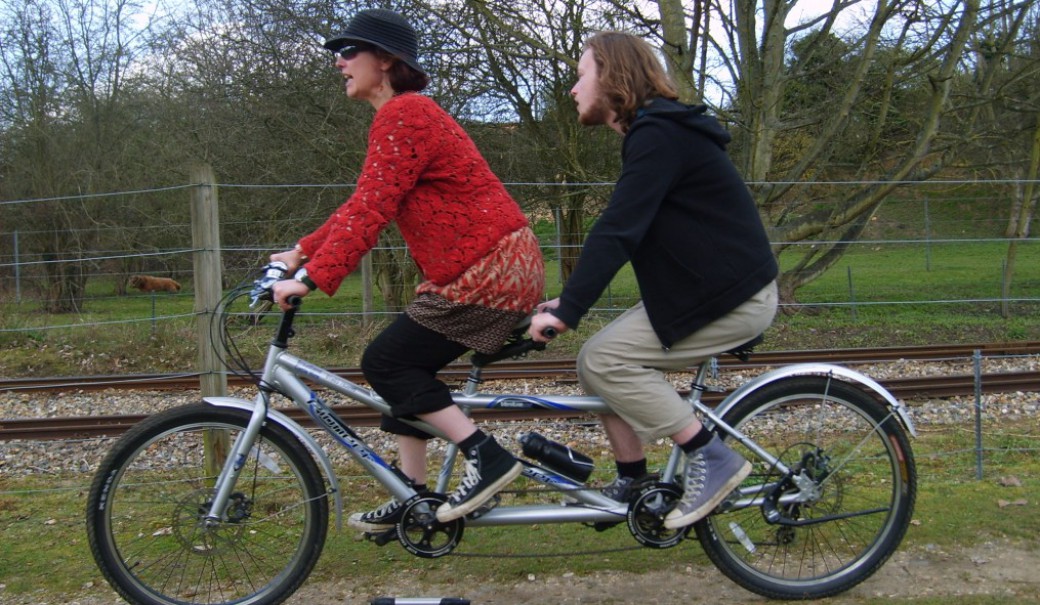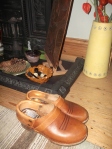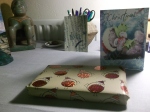
When Dylan first moved to residential care one of the things that made me anxious was the idea of not being there for him if he became upset or was ill. The setting isn’t far from where I live, relatively speaking, but the quickest cross-country route from home takes 50 minutes; as it’s all but impossible by public transport I worry about being unable to drive.
As I’m not a particularly confident driver my anxieties about not being able to get to Dylan are compounded by bad weather. I know emergencies are rare and that the chances of Dylan having an accident don’t increase when it is snowing (well, perhaps a smidge). I also accept that there is no need for me to drive to the home in response to minor incidents; familiar staff are there to support Dylan at such times. So it ought to be possible not to worry about the weather, even when conditions are arctic. This is not, however, necessarily the case.
Routine Emergency
 One of the most important things to Dylan is his visual programme. He has various routines around this, one of which is that he likes his week to end on the day he comes home. Dylan really enjoys looking through his ‘new programme’ with me while he is visiting. For this to work, however, we need to agree Dylan’s weekly programme two or three days before he comes home for the weekend. What this means is that some of his activities are planned as much as ten days before they are to happen. The weather forecast is not something that can be reliably factored into planning.
One of the most important things to Dylan is his visual programme. He has various routines around this, one of which is that he likes his week to end on the day he comes home. Dylan really enjoys looking through his ‘new programme’ with me while he is visiting. For this to work, however, we need to agree Dylan’s weekly programme two or three days before he comes home for the weekend. What this means is that some of his activities are planned as much as ten days before they are to happen. The weather forecast is not something that can be reliably factored into planning.
At the height of last week’s snowfall, all planned activities at Dylan’s residential setting had to be cancelled as it was no longer safe to transport residents by car. This meant that a programme change had to be communicated – not easy for Dylan, but he accepted it well and was happy to spend time in the snow instead. The possibility that Dylan might not make it home at the weekend, however, worried me; this was not a disruption to routine that Dylan would so easily accept.
Essential Work
 As well as feeling anxious about getting myself to Dylan’s home I worried about whether the care home staff could get to work. I know this is not my responsibility but because staffing is essential in a setting such as Dylan’s I still thought about it. The residents are bound to be unsettled by the change in routine and the inability to make trips out means they have to spend more time in the home together than usual. This is potentially a tricky situation and the best resource is plenty of staff.
As well as feeling anxious about getting myself to Dylan’s home I worried about whether the care home staff could get to work. I know this is not my responsibility but because staffing is essential in a setting such as Dylan’s I still thought about it. The residents are bound to be unsettled by the change in routine and the inability to make trips out means they have to spend more time in the home together than usual. This is potentially a tricky situation and the best resource is plenty of staff.
I need not have worried of course; the managers had everything under control and the staff did what essential workers do and made it through the snow to the home. When I asked how they had managed on the worst of the snow days, one member of staff told me that those who had got through ‘stayed on’, doing double shifts and sleeping over. So while I spent most of the week working from home, work at Dylan’s home continued as normal.
No Snow Drama
 This triggered two reflections. Firstly, that when we refer to ‘essential workers’ at times of extreme weather or public holiday we rarely think about the thousands of staff who work in residential settings supporting the most vulnerable members of society. Because the focus in such settings is about keeping residents calm and comfortable by maintaining routine and structure, snow and ice doesn’t generate dramatic footage for the national news. Workers driving emergency response vehicles, Chinook helicopters and roadside recovery trucks may appear more heroic, but my heroes last week were the staff who took care of Dylan without turning the weather into a drama.
This triggered two reflections. Firstly, that when we refer to ‘essential workers’ at times of extreme weather or public holiday we rarely think about the thousands of staff who work in residential settings supporting the most vulnerable members of society. Because the focus in such settings is about keeping residents calm and comfortable by maintaining routine and structure, snow and ice doesn’t generate dramatic footage for the national news. Workers driving emergency response vehicles, Chinook helicopters and roadside recovery trucks may appear more heroic, but my heroes last week were the staff who took care of Dylan without turning the weather into a drama.
The second thing was a memory of when Dylan was living at home. The experience is still recent enough for me to remember how challenging it was to keep Dylan calm and happy during extreme weather. The disruption to Dylan’s routine if his school or day centre was closed, and the difficulty of being confined to a relatively small space, without access to the therapeutic resources and spaces he needs, would often trigger anxiety and frustration. Recalling this, I was glad that Dylan was not only safe, but in the best possible place.
Weekend Work
 There have been wintry weekends while Dylan has lived at his residential home but they have never prevented me from collecting Dylan for a home visit. With England in the grip of extreme weather, however, the situation was different. By the end of the week I had accepted that I could not get to Dylan and that he was safest staying where he was. The snow was so heavy that rather than fret about how Dylan would respond I settled into the idea; there was nothing could be done and it would probably be good for me to have a break from caring for Dylan.
There have been wintry weekends while Dylan has lived at his residential home but they have never prevented me from collecting Dylan for a home visit. With England in the grip of extreme weather, however, the situation was different. By the end of the week I had accepted that I could not get to Dylan and that he was safest staying where he was. The snow was so heavy that rather than fret about how Dylan would respond I settled into the idea; there was nothing could be done and it would probably be good for me to have a break from caring for Dylan.
In the event, however, one of the support workers (a more confident driver than me) brought Dylan to me and collected him the next day. Although this was not quite the routine Dylan was used to it meant he had some time at home as well as relieving pressure on staff at the residential home. Dylan and I enjoyed our time together but I was a bit anxious about not being able to take him out for an activity as I usually do. This made me realise that Dylan and I have constructed a weekend routine which isn’t sustainable; there will be other times when the weather closes in and (in due course) age and ill-health to prevent me from looking after Dylan. I need to prepare us both for this somehow. I think an unsnowy break from our weekend routine may be on the horizon…

Dylan enjoying himself in the residential snow…


 One of the things I enjoy about being at home for Christmas is the way it helps me to see familiar objects in a new light. This is partly a consequence of living in a smallish house; to make space for a Christmas tree I have to move things around a little. This year, the tree is behind the front door. As well as creating challenges for Postie and me (I have to scramble beneath the tree to retrieve the mail as he slides it gently through the flap) it means Dylan’s favourite picture is currently obscured by spruce.
One of the things I enjoy about being at home for Christmas is the way it helps me to see familiar objects in a new light. This is partly a consequence of living in a smallish house; to make space for a Christmas tree I have to move things around a little. This year, the tree is behind the front door. As well as creating challenges for Postie and me (I have to scramble beneath the tree to retrieve the mail as he slides it gently through the flap) it means Dylan’s favourite picture is currently obscured by spruce.
 In ‘Lighteater’ I celebrate Dylan’s relationship with the sun. When I look at Spiritus, I see rain. I like the fact that the companionship between poem and print is elemental, rather than literal; this bringing together of light and water seems to me to be at the heart of their dialogue. The pairing of verbal and visual text also helps me to understand something about Dylan; that his fascination with water is perhaps, at least partly, about its relationship with light.
In ‘Lighteater’ I celebrate Dylan’s relationship with the sun. When I look at Spiritus, I see rain. I like the fact that the companionship between poem and print is elemental, rather than literal; this bringing together of light and water seems to me to be at the heart of their dialogue. The pairing of verbal and visual text also helps me to understand something about Dylan; that his fascination with water is perhaps, at least partly, about its relationship with light. I’ve written about the social enterprise activity linked to Dylan’s care setting in
I’ve written about the social enterprise activity linked to Dylan’s care setting in  One of the factors which seemed to be key to Dylan’s engagement with the social enterprise activity was the coordinator (I’ll call him A) with whom Dylan developed an excellent relationship. Dylan seemed to realise that A had a different role to the other staff at the home and this allowed Dylan to adopt a different approach to the relationship. The difference is subtle but significant; because the coordinator is not involved in personal care, an alternative form of trust and closeness was able to develop.
One of the factors which seemed to be key to Dylan’s engagement with the social enterprise activity was the coordinator (I’ll call him A) with whom Dylan developed an excellent relationship. Dylan seemed to realise that A had a different role to the other staff at the home and this allowed Dylan to adopt a different approach to the relationship. The difference is subtle but significant; because the coordinator is not involved in personal care, an alternative form of trust and closeness was able to develop.






 What I am struck by is how important these seasonal rhythms are to Dylan. I suppose if you don’t use speech to communicate and have only limited communication, ’embodied’ sense-making through familiar activities is important. I have often thought of Dylan as needing consistency in his life but perhaps it would be more accurate to think of him as needing constancy. The difference between the two is that consistent things do not vary, though they may start and stop, whereas something that is constant does not stop, although it may vary. Dylan seems to be able to manage everyday variations – the absence of a face, a change of detail – providing the anchoring rhythms remain.
What I am struck by is how important these seasonal rhythms are to Dylan. I suppose if you don’t use speech to communicate and have only limited communication, ’embodied’ sense-making through familiar activities is important. I have often thought of Dylan as needing consistency in his life but perhaps it would be more accurate to think of him as needing constancy. The difference between the two is that consistent things do not vary, though they may start and stop, whereas something that is constant does not stop, although it may vary. Dylan seems to be able to manage everyday variations – the absence of a face, a change of detail – providing the anchoring rhythms remain.
































